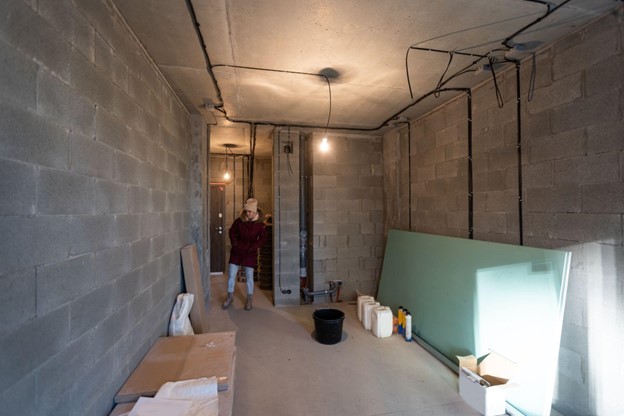What Do I Wish I Knew Before Finishing the Basement?
There’s more to finishing a basement than picking paint colors. First off, know your local building codes and make sure you get the right permits. It can save you from major headaches later.
Insulation matters more than you’d think. The right type keeps your space comfortable and helps with energy efficiency. Moisture control is just as important. Keeping the basement dry protects your investment and prevents future problems.
Plan your electrical and plumbing needs early. It’s much easier to run everything before the walls go up.
Finally, think about how you’ll use the space. A bit of planning around layout and function can turn an ordinary basement into one of the best areas in your home.
What to Know About Permits and Building Codes Before Renovating
Before you plunge into finishing your basement, it’s vital to understand the building codes and permits that apply to your project. Maneuvering through local regulations can feel overwhelming, but it’s essential for avoiding headaches later.
Start by checking your municipality’s requirements for permit applications; each area has specific guidelines that dictate what’s needed for your renovation. Once you’ve submitted your applications, prepare for building inspections, which confirm your work meets safety standards.
These inspections might cover electrical, plumbing, and structural elements, so be ready to showcase your progress. By staying informed and compliant, you’ll not only keep your project on track but also enhance the value and safety of your finished basement.
The Importance of Proper Insulation
After sorting out permits and codes, the next thing to focus on is insulation. Getting it right makes a big difference in how your basement feels and functions.
There are a few solid options to consider—fiberglass batts, spray foam, and rigid foam boards. Each has its own pros, depending on your budget and the layout of your space.
Good insulation keeps the temperature steady, cuts down on energy bills, and helps keep things warm in the winter. It also makes the basement feel more like part of your home, not just a chilly storage area.
Take the time to do it right, and your basement will be a lot more comfortable and useful in the long run.
Moisture Control and Waterproofing Solutions
Many homeowners underestimate the importance of moisture control when finishing their basements. Without proper measures, you’re setting yourself up for potential water damage and mold growth.
Start by installing effective drainage systems to direct water away from your foundation. This includes gutters, downspouts, and French drains that can greatly reduce moisture levels.
Next, don’t overlook the installation of vapor barriers. These barriers prevent moisture from seeping through walls and floors, protecting your finished space.
It’s essential to seal any cracks in the foundation as well. By prioritizing moisture control and waterproofing solutions, you can guarantee a comfortable, dry, and livable basement for years to come.
Taking these steps now will save you time, money, and hassle later.
Planning for Electrical and Plumbing Needs
When you plunge into finishing your basement, it’s important to plan for your electrical and plumbing needs early on.
Start by mapping out your electrical layout. Consider where you’ll need outlets, lighting, and any specialized equipment. This will help guarantee you have enough power for all your needs.
Next, think about the plumbing fixtures you’ll want, whether it’s a bathroom, wet bar, or laundry area. Make certain to account for proper drainage and water supply lines.
Hiring a qualified electrician and plumber can save you headaches later, so don’t hesitate to seek professional help.
Designing for Functionality and Aesthetics
After addressing your electrical and plumbing needs, it’s time to focus on designing a space that’s both functional and aesthetically pleasing.
Start by considering space optimization; arrange furniture to maximize flow and usability. Think about how each area will be used, whether it’s for entertaining, relaxing, or storage.
Next, choose a cohesive color palette that reflects your style and enhances the basement’s natural light. Lighter colors can make the space feel larger, while darker tones can create a cozy atmosphere. Incorporate accent pieces that tie the look together without overwhelming the room.
Finally, balance functionality with aesthetics by selecting multi-purpose furniture, ensuring your basement isn’t just beautiful but also practical for everyday use.
Frequently Asked Questions
What Is the Average Cost to Finish a Basement?
Finishing a basement typically costs between $10,000 and $30,000. You should consider a cost breakdown for materials, labor, and permits while budget planning to guarantee you stay within your financial limits.
How Long Does the Basement Finishing Process Typically Take?
When you envision a quick transformation, remember that reality often brings project delays. Typically, basement finishing takes four to eight weeks, so set your timeline expectations accordingly to avoid frustration and guarantee a smooth process.
Can I Finance My Basement Finishing Project?
You can definitely finance your basement finishing project. Explore various basement financing options like home equity loans or renovation loan types to find the best fit for your budget and renovation goals. It’s worth considering!
What Are Common Mistakes to Avoid During Basement Finishing?
When finishing your basement, avoid common mistakes like poor insulation, which leads to temperature issues, and inadequate lighting, making the space feel cramped. Plan carefully to create a comfortable, inviting area you’ll love.
How Do I Choose the Right Contractor for My Project?
Choosing the right contractor’s like finding a needle in a haystack. Look for qualifications, check reviews, and guarantee they understand your project timeline. A good contractor will make your vision come alive smoothly and efficiently.

